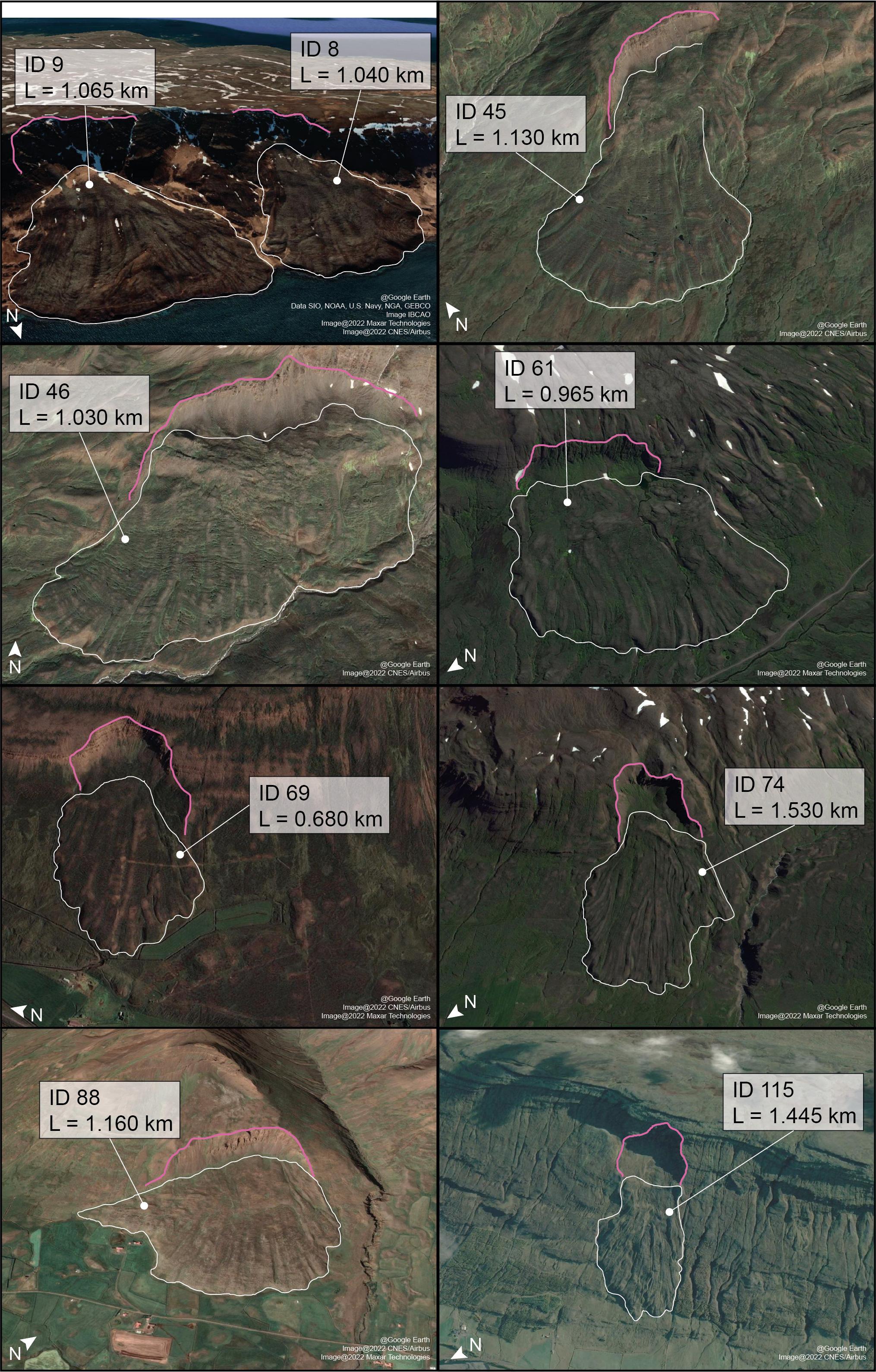Long runout landslides in the Solar System.
The mobility of long runout landslides remains not fully understood. Despite the large number of case studies available, the variety of mechanisms proposed to explain the reduction of friction involved, and modelling contribution, many fundamental aspects remain unresolved: the effects of gravity and volume; the role of fluids; the origin of high velocities; the formation and preservation during emplacement of morphological features and internal structures.
1. Longitudinal ridges in long runout landslides.
Scaling relationship between the wavelength of longitudinal ridges and the thickness of the landslide deposit - implications for the formation mechanism of longitudinal ridges.
Longitudinal ridges are distinct morphological features that extend in the direction of movement of many long runout landslides. From the morphometric analysis condcuted on longitudinal ridges in three case studies (Coprates Labes landslide, Mars; El Magnifico landslide, Earth; the Tsiolkovskiy landslide, Moon), it emerges that the wavelength of longitudinal ridges in long runout landslides scales with the thickness of the landslide deposit. The recurrence of the same scaling relationship between the wavelength of longitudinal ridges and the thickness of the landslide deposit on three different planetary bodies suggests that the mechanism involved in the formation of longitudinal ridges is independent of environmental conditions. Moreover, this scaling relationship is in agreement with ice-free experimental work on rapid granular flows, suggesting that the mechanism is also scale-independent.
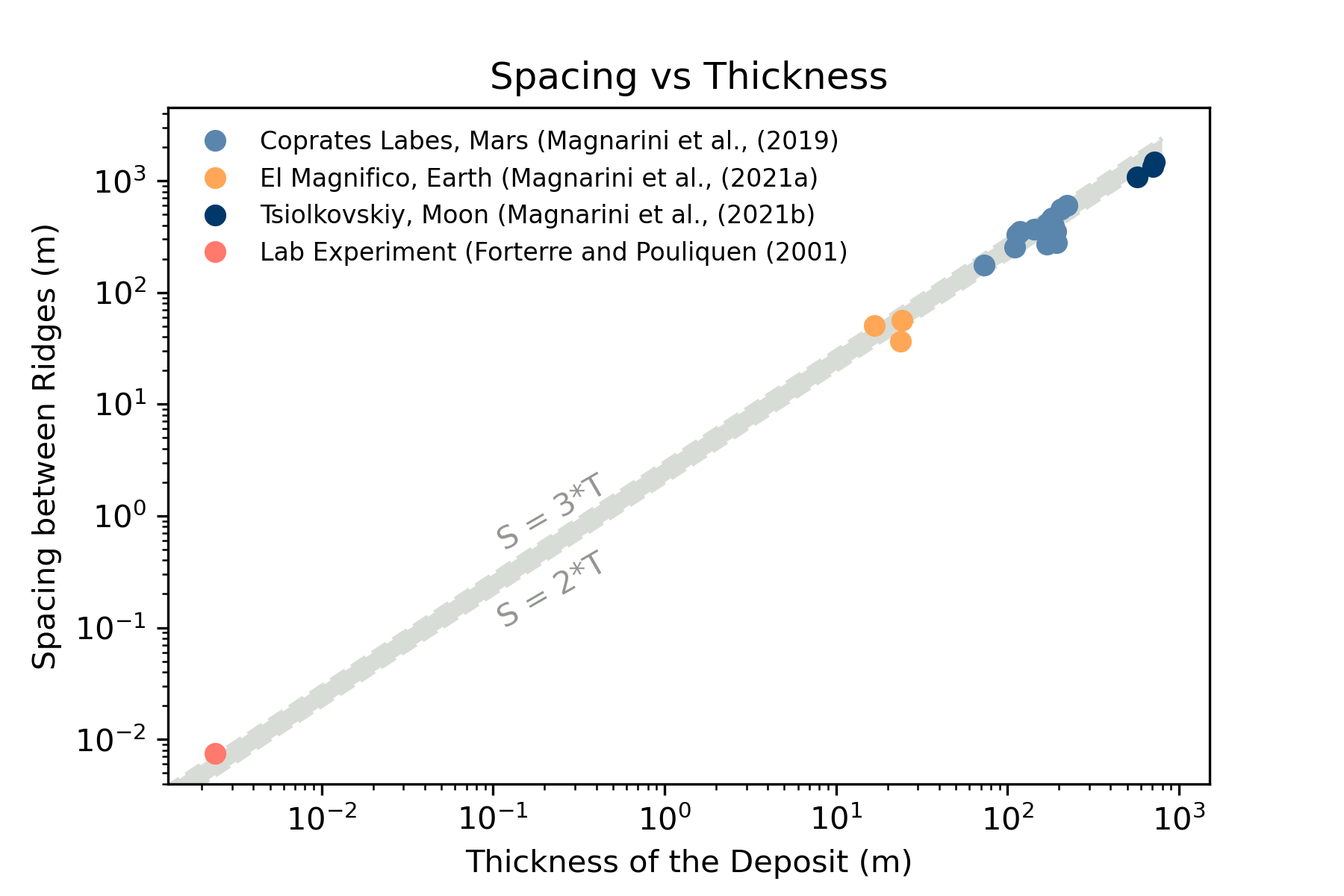
Longitudinal ridges are commonly associated with long runout alndslides emplaced on glaciers. Therefore, the presence of basal ice is suggested to provide a low friction surface that allows the landslide to spread and undergoing tensile deformation, thereby explaining both the hypermobility of the landslides and the formation of longitudinal ridges. However, long runout landslides with longitudinal ridges are not exclusive to supre-glacial environments (e.g., on the Moon, which is considered to be free of ice throughout its geological history; in Northern part of the Atacama Desert, Chile, at a time when ice-free, low-altitude coastal areas and regional hyper-arid conditions were long established).
We conceptualize the occurrence of a vibrated-assisted mechanism and a convection-type mechanism as a continuum that is dependent on both the lithologies involved, the duration of the event and the velocity (i.e., energy) at play. Critically, both mechanisms rely on the same type of energy input, vibrations. A mechanical instability would emerge generating a convection-style of motion when conditions of certain lithologies, velocity and stresses brecciate the sliding mass to the point that it behaves in the manner of a granular flow. In some cases, this extreme mechanical instability may not emerge and pattern-forming vibration within the sliding mass may, in this case, dominate.
For more details: Magnarini et al. (2019) Longitudinal ridges imparted by high-speed granular flow mechanisms in martian landslides. Magnarini et al. (2021) Implications of longitudinal ridges for the mechanics of ice-free long runout landslides. Magnarini et al. (2021) Scaling Relationship Between the Wavelength of Longitudinal Ridges and the Thickness of Long Runout Landslides on the Moon.
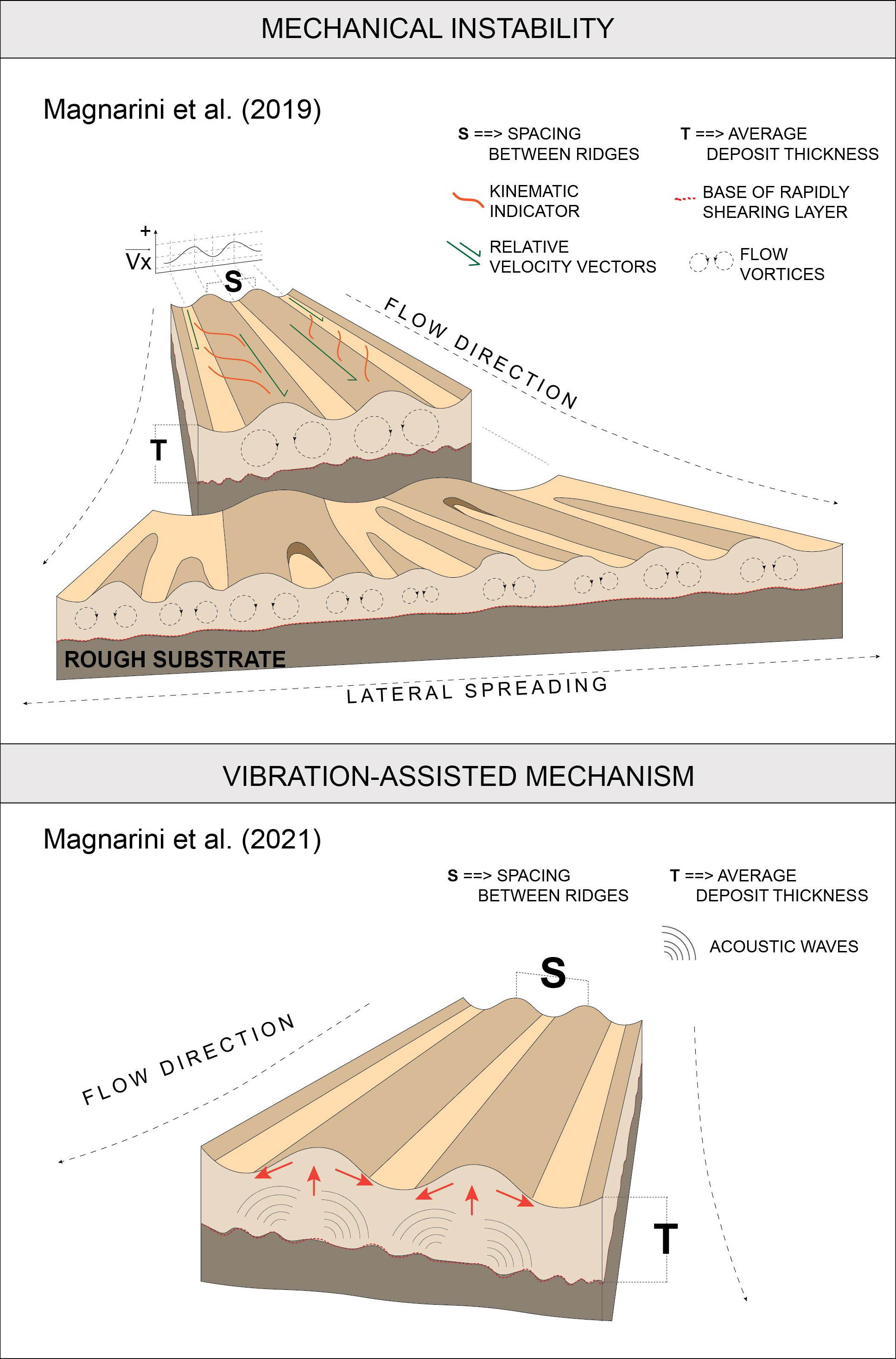
2. Friction experiments in lunar analogue materials.
Implications for the hypermobility of the Light Mantle landslide.
Evidence for the presence of long runout landslides on the Moon opened important implications for mechanisms of the reduction of friction on planetary bodies in the absence of atmosphere and water availability. The exceptional 5-km-long runout made the Light Mantle landslide deposit one of the primary geological targets of the Apollo 17 mission. The origin of its hypermobility remains undetermined, as the proposed mechanisms are difficult to prove because of the lack of theoretical and experimental support and the scarcity of field data related to the internal structures of its deposit. Given the importance of friction weakening mechanisms in the development of terrestrial long runout landslides, in this study, for the first time, we perform low atmosphere (high-vacuum) friction experiments on lunar analog anorthosite-bearing gouges (i.e., rock powders) to test the theoretical viability of thermally activated dynamic weakening mechanisms in lunar analog material. We use a high velocity rotary shear apparatus (SHIVA, Slow to High-Velocity Rotary Shear Apparatus, Di Toro et al., 2010) at the Istituto Nazionale di Geofisica e Vulcanologia in Rome (Italy) to determine the viability of thermally activated dynamic weakening mechanisms that could explain the exceptional runout of the Light Mantle landslide.
The anorthositic material appears to have high dynamic shear strength. No evidence of dynamic weakening is seen at conditions for which it occurs in other materials. This result suggests that friction weakening mechanisms did not take place during the initiation of the Light Mantle landslide; therefore, other mechanisms must have dominated the landslide emplacement and be responsible for its excessive runout distance.
For more details: Magnarini et al. (2023) Friction Experiments on Lunar Analog Gouges and Implications for the Mechanism of the Apollo 17 Long Runout Landslide
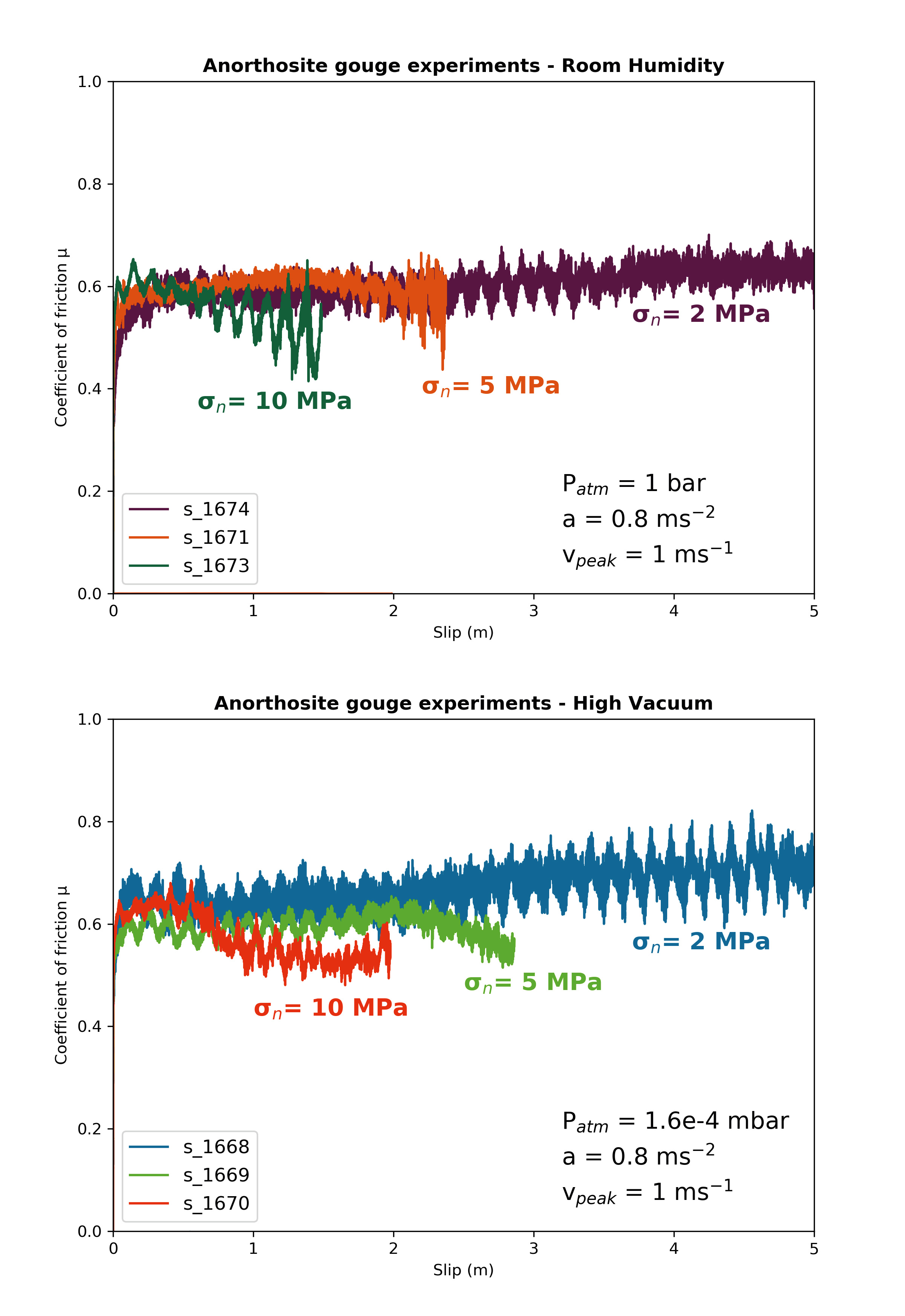
Microstructural clast observations: keys to the analysis and interpretation of the Apollo 17 core samples 73001/73002.
Microstructural observations of the frictionally-modified material recovered after the experiments show clast fabrics and morphologies that have been described in the basal slip zone of large terrestrial landslides. These are Clast Cortex Aggregates (CCAs), which are made of a central clast surrounded by fine-grained fragments derived by the breaking of the clast edges. Our initial investigation of clasts of the Apollo 17 73002 sample (under the NASA ANGSA program) reveals several clasts presenting fabric (i.e., spatial and geometric configuration of their elements, such as fractures, zonation) and morphology (i.e., particle shape) similar to those obtained experimentally during friction tests. This suggests that clasts of the Apollo 17 core samples may have fabric and morphology that yield infor-mation about mechanisms involved during the em-placement of the Light Mantle landslide. However, further analysis and comparison with other lunar samples will help in defining whether thse clast structures are associated with the landslide emplacement or other processes.
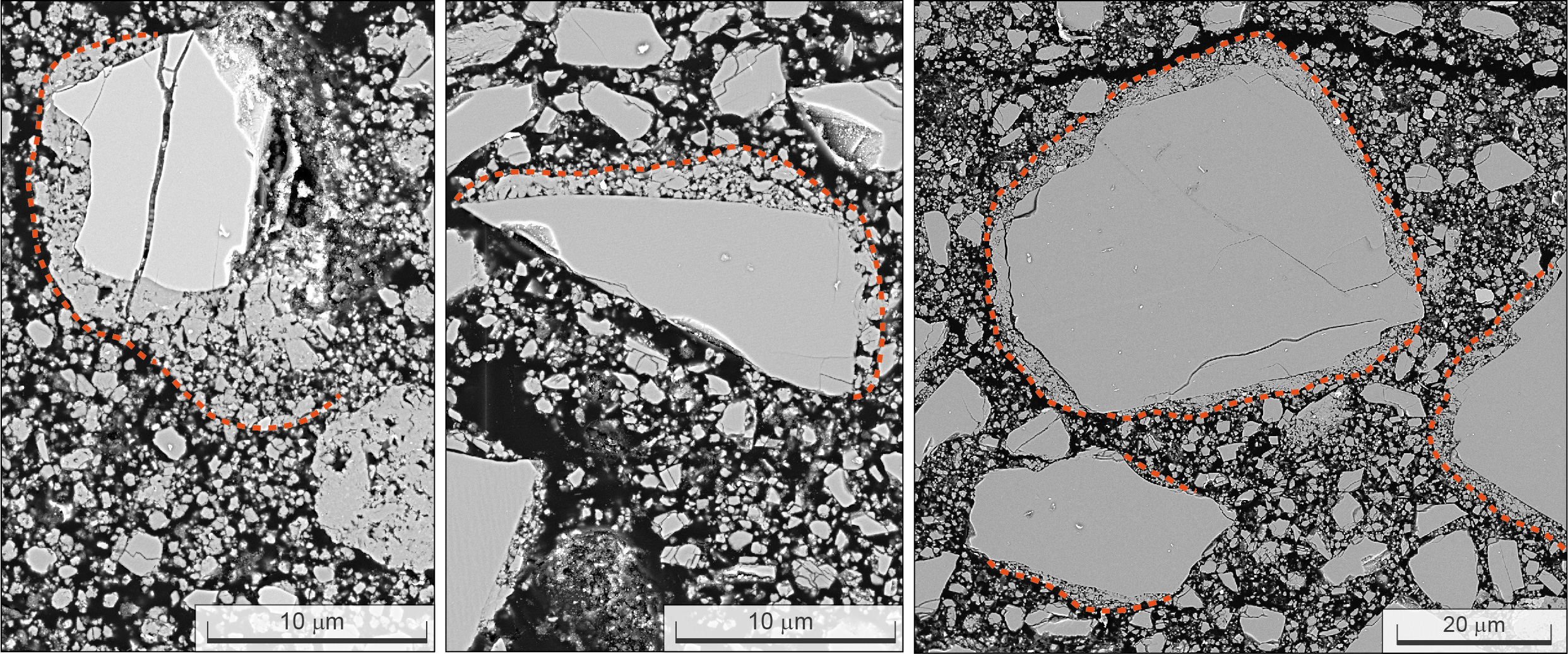
3. Long runout landslides in Iceland.
Icelandic landslides as analogue of martian landforms.
On Earth, there are not as many well-preserved cases of long runout landslides with associated longitudinal ridges as there are on Mars. Such difference might suggest that longitudinal ridges in long runout landslides do not commonly form on our planet. However, more than one hundred landslides characterised by longitudinal ridges are easily identifiable in Iceland, making it an exceptional region on Earth for its high spatial density of such landforms. The unique record of long runout landslides with longitudinal ridges in Iceland suggests that either longitudinal ridges are indeed common in long runout landslides on Earth, but their record is more easily lost on our planet; or conditions in Iceland, at the time of landslide formation, were optimal for the development of these landforms. The study of long runout landslides with longitudinal ridges in Iceland represents an opportunity to investigate the formation mechanisms of such hypermobile landslides and their possible link with past environmental conditions. A better understanding of the influence of climatic, geological, and environmental conditions in the development of hypermobile landslides will have implications for both terrestrial hazard assessment and reconstruction of extra-terrestrial paleo-environments.
In addition to morphometric comparability, our morphological observations show that Icelandic long runout landslides share similar structure behaviours with martian analogue deposits, such as splitting of longitudinal ridges and development of en-echelon features. Therefore, Icelandic long runout landslides with longitudinal ridges represent good analogues of martian landforms.
For more details: Magnarini et al. (2023) Long Runout Landslides with Associated Longitudinal Ridges in Iceland as Analogues of Martian Landforms. (preprint discussion)
